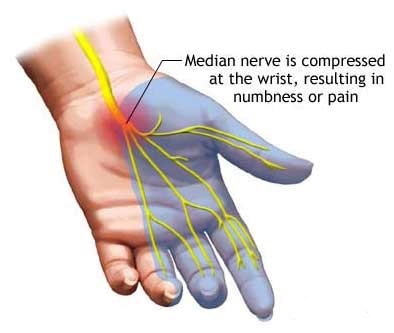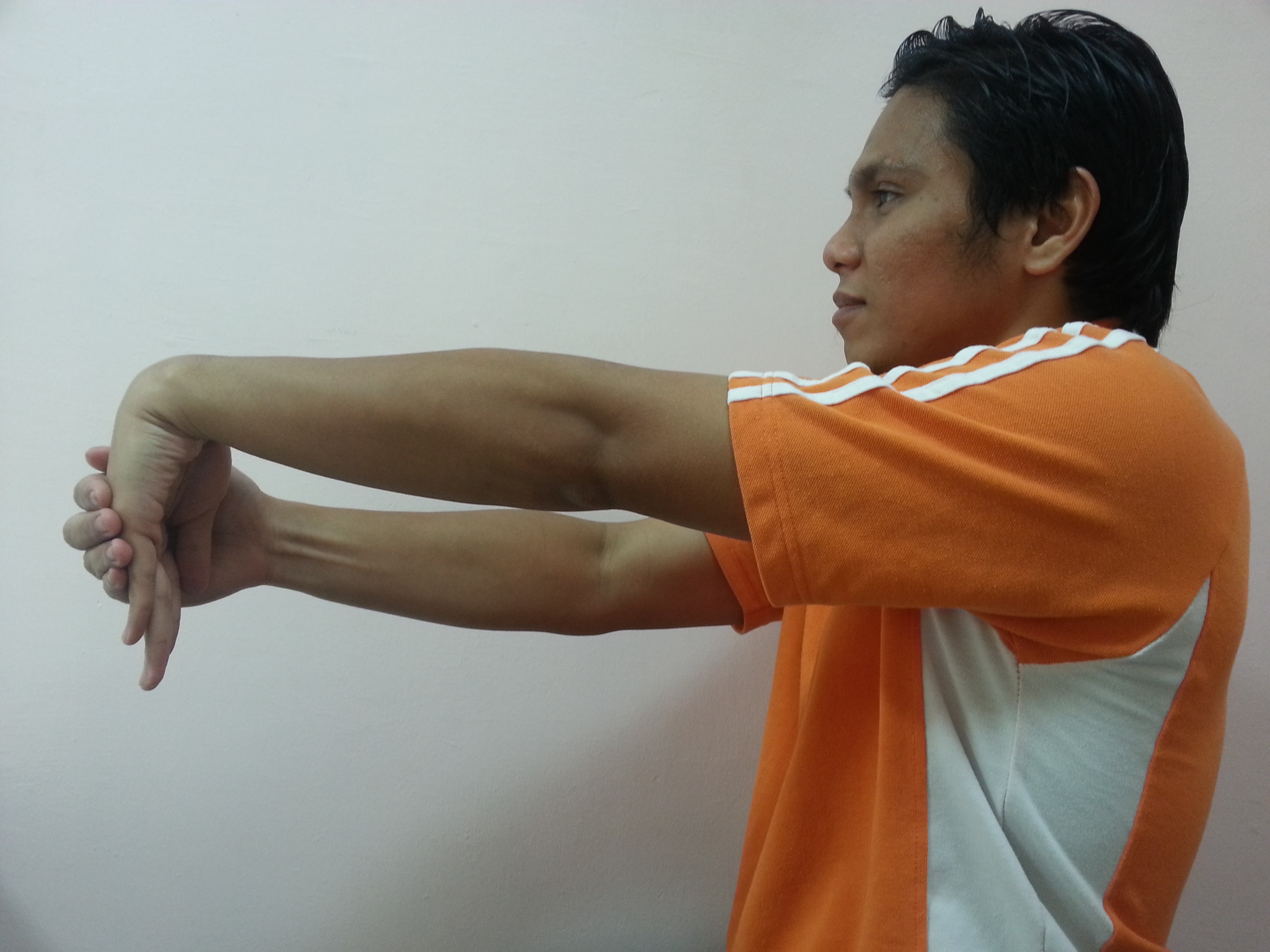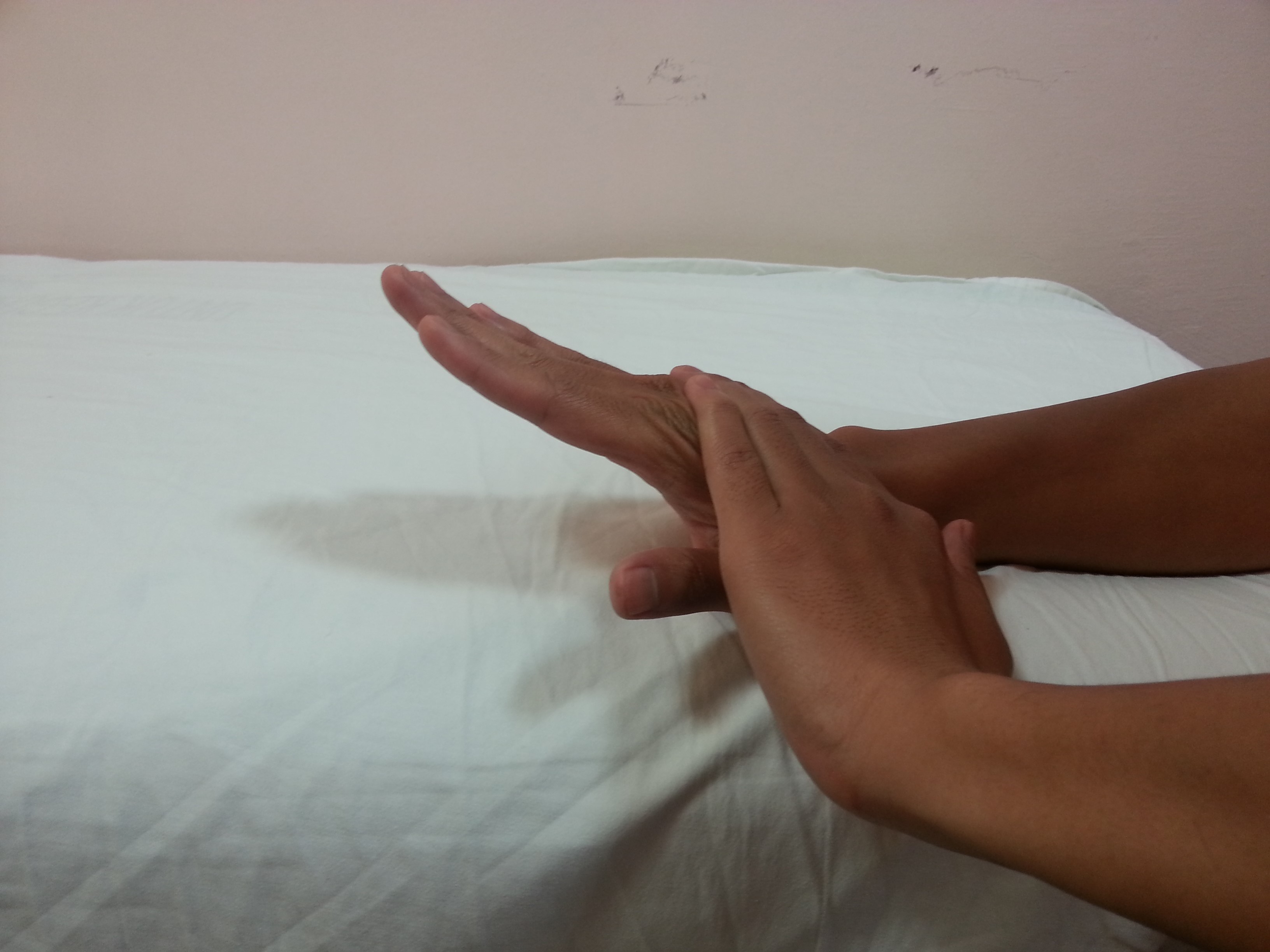What is Carpal Tunnel Syndrome?
Carpal Tunnel Syndrome (CTS) is a nerve disorders can result from repeated pressure on a median nerve. The median nerve is squeezed where it passes through the wrist. Also be referred to Cumulative Trauma Disorders. Develop gradually over weeks, months or years.
 |
| Picture 1: Compression on median nerve & area involved Source: www.adamimages.com/ |
How Carpal Tunnel Syndrome can happen?
- Caused by repetitive movements, awkward postures, forceful exertions, vibration or compression (pressing against hard surfaces).
- The tendons in the wrist have become swollen and they press on the median nerve
- It’s causing pain, aching, tingling or numbness in the affected hand
What are the symptoms of Carpal Tunnel Syndrome?
- Pain along the wrist joint line worse at night and may disturb sleep. Sometimes, it causes morning pain
- Pain during certain activities such as writing, typing or doing housework
- Numbness and tingling sensation along the shaded area (thumb, index finger, middle finger and half of the ring finger) Picture 1
- Decreased manual dexterity
Risk factors
The factors can be divided into:
Individual factors
- Routine exercise. Routine exercise (Carter J, Banister E., 1994) and frequent stretching is recommends in cases of Carpal Tunnel Syndrome (The Official Guidelines, 2005).
- Smoking status. Smoking cessation has an influence reduction in musculoskeletal disorders (Korhonen T.,et. al.,2003)
Organizational factors
- Work task variety. Increased work task variety(Bergqvist U., 1995) and alternate computer tasks with non computer tasks whenever is recommended (Occupational Safety and Health Administration).
- Rest break opportunities. Increased rest break opportunities(Ortiz-Hernandez L, 2003) and limited opportunities for rest breaks are the major causative factor in many musculoskeletal disorders (Galinsky TL. et. al., 2000).
- Exercise opportunities. Increased exercise opportunities (Ortiz-Hernandez L, 2003) and frequent short stretch breaks were effective in reducing stiffness, muscle ache and stress (Saltzman, 1998).
Ergonomic factors
- Changes to workstation. Ergonomic changes to workstation are the most frequently employed interventions (Sauter SL, Schleifer LM, Knutson SJ., 1991) and proper workstation ergonomics to the Stretch Break program increased productivity (Saltzman, 1998).
What are the quick tests for Carpal Tunnel Syndrome?
- Palpable pain along affected wrist joint. Picture 2
- Phalen test. Picture 3
 |
| Instruction Position : Support affected hand & forearm Action : Palpate affected area by other index & middle fingers Positive sign : Sharp pain |
| Picture 2: By palpation |
|
Source: Unit Fisioterapi Hospital Melaka |
 |
| Instruction Position : Fold both hand together Action : Hold for at least 1 minute Positive sign : Numbness along the wrist & hand |
| Picture 3: Phalen Test |
|
Source: Unit Fisioterapi Hospital Melaka |
How exercise can ease Carpal Tunnel Syndrome
Physiotherapist helps to ease pain and prevent future injuries and can be generally manage intervention as follows:
Passive interventions
- Pain relief
- Heat modalities, cold therapy, pulsed ultrasound and shockwave therapy showed better outcomes in relieving pain
- Splints
- Wearing a resting splint can help prevent the symptoms occurring at night
- Working splint can be useful if the symptoms are aggravated by particular activities
- Massage and Tapping techniques
- Transverse friction massage had the best effects in the short and long term (Stasinopoulos D. et. al., 2004)
Active interventions
- Stretching exercise
 |
 |
| Wrist bend upward Position : Keep the elbow straight & palm facing down Instruction : Bend wrist up – Use the opposite hand to press the stretching hand back towards the body (hold 15-30 secs). Do gently (10 repetitions/ 3 sets) |
Wrist bend downward Position : Keep the elbow straight & palm facing down Instruction : Bend wrist down – Use the opposite hand to press the stretching hand back towards the body (hold 15-30 secs). Do gently (10 repetitions/ 3 sets) |
Source: Unit Fisioterapi Hospital Melaka
Mobility exercise
 |
 |
 |
| Wrist bend (forward and back) Position : Support the elbow. Arm pointing up & wrist straight Instruction : Bend wrist forward (hold 5 secs) – Straighten wrist – Bend backward (hold 5 secs) Do gently (10 repetitions/ 3 sets) |
| Source: Unit Fisioterapi Hospital Melaka |
Strengthening exercise
 |
 |
| Forearm muscle Position: Support the elbow & place affected palm on the table. Place other hand across the affected knuckles at 900 & push down Instruction : Push affected hand upward (hold 5 secs) Do gently (10 repetitions/ 3 sets) |
| Source: Unit Fisioterapi Hospital Melaka |
 |
| Hand muscle Position : Support the elbow & held fingers out straight Instruction : Squeeze a rubber ball (hold 5 secs) Do gently (10 repetitions/ 3 sets) |
| Source: Unit Fisioterapi Hospital Melaka |
Education
- Carpal Tunnel Syndrome can usually be easily treated
- Symptoms tend to be worse at night – hang your hand out of bed or shake it around to ease pain
- Certain activities can bring on symptoms. Wearing a working wrist splint may be helpful
- Rest breaks have also been recommended to decrease musculoskeletal discomfort
- Occupational Safety and Health Administration (OSHA) make the following recommendations to decrease musculoskeletal discomfort:
- Stretch the fingers, hands and arms frequently throughout the day
- Take several short breaks
- Stand up and walk for a few minutes periodically
- Alternate computer tasks with non-computer tasks whenever possible
- Make small adjustments to the desk chair
- The pain should ease within 2 weeks and recover over approximately a 4 to 6 weeks period
- The recommendation exercises above should continue for at least 6 to 8 weeks to help prevent symptoms returning.
References
- Official Disability Guidelines Treatment in Workers’ Compensation, 3rd ed.Encinitas, CAS: Work-Loss data Institute, 2005
- Ronald De Vera Barredo, Kelly Mahon. The effects of exercise and rest breaks on Musculoskeletal discomfort during computer tasks: An evidence-based perspective . J. Phys. Ther. Sci. 2007;19:151–163.
- Carter J, Banister E.: Musculoskeletal problems in VDT work: a review. Ergonomics. 1994;37:1623–1648. 16
- Korhonen T, Ketola R, Toivonen R. et. al.: Work related and individual predictors for incident terminal workers: individual, ergonomic and work organizational factors. Ergonomics, 1995;38:763-776. 21
- Ortiz-Hernandez L, Tamez-Gonzales S, Martinez-Alcantara S. et. al.: Computer use increases the risk of musculoskeletal disorders among newspaper office workers. Arch Med Res, 2003;34:331-342. 23
- Sauter SL, Schleifer LM, Knutson SJ: Work posture, workstation design and musculoskeletal discomfort in a VDT data entry task. Hum Factors,1991;33:151-167. 7
- Saltzman A: Computer user perception of the effectiveness of exercise mini breaks. In: Proceedings of the Silicon Valley Ergonomic Conference and Exposition. Silicon Valley, CA,1998;147-151. 31
- Galinsky TL, Swanson NG, Sauter SL,et. al.: A field study of supplementary rest breaks for data-entry operators. Ergonomics 2000;622-638. 9
Source image
- (2015) Unit Fisioterapi Hospital Melaka. Retrieved October 29 2015.
| Last Reviewed | : | 23 August 2019 |
| Writer | : | Mohd Naqiuddin bin Johar |
| Accreditor | : | Se To Phui Lin |
| Reviewer | : | Halimah bt. Hashim |







